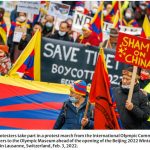Liza Lin, Eva Xiao and Jonathan Cheng for The Wall Street Journal.
MAQEN, China—A quiet state-run campaign is ramping up the assimilation of one of China’s most recognizable minorities.
At Lari, a small Tibetan Buddhist monastery in the Qinghai province, devotees spin prayer wheels under the watchful eye of surveillance cameras and a large portrait of Chinese leader Xi Jinping.
To the north, monks at the 127-year-old Xin Monastery say new restrictions on youth participation are making it hard to bring in recruits. Across the region, schools are slashing recruitment of teachers who give classes in Tibetan and replacing traditional artwork with posters of Chinese leaders.
Mr. Xi has made it a national priority to forge a single Chinese identity in the name of unity—one centered around the Han Chinese majority and loyalty to the Communist Party. The government’s campaign is known in the West primarily through its efforts to assimilate Uyghurs and other mostly Muslim minority groups in the northwest region of Xinjiang. Under the radar, China’s population of 6.3 million Tibetans has become a primary target.
Beijing has placed new restrictions on Tibetan religion, education and language, while increasing its ability to keep constant watch over individuals. Although less heavy-handed, the tactics build on an effort that has played out in Xinjiang, where ethnic minorities have been subject to mass digital surveillance and as many as 1 million have been sent through a sprawling network of internment camps. Government authorities have described the sites as vocational schools.
Former Chinese leaders believed economic development would naturally integrate ethnic minorities into mainstream society. Mr. Xi has opted for a more hard-line approach, with the government taking an active role in shaping minorities’ cultural identity.
Click here to read more











